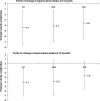Reduction in consumption of sugar-sweetened beverages is associated with weight loss: the PREMIER trial
- PMID: 19339405
- PMCID: PMC2676995
- DOI: 10.3945/ajcn.2008.27240
Reduction in consumption of sugar-sweetened beverages is associated with weight loss: the PREMIER trial
Abstract
Background: Consumption of liquid calories from beverages has increased in parallel with the obesity epidemic in the US population, but their causal relation remains unclear.
Objective: The objective of this study was to examine how changes in beverage consumption affect weight change among adults.
Design: This was a prospective study of 810 adults participating in the PREMIER trial, an 18-mo randomized, controlled, behavioral intervention trial. Measurements (weight, height, and 24-h dietary recall) were made at baseline, 6 mo, and 18 mo.
Results: Baseline mean intake of liquid calories was 356 kcal/d (19% of total energy intake). After potential confounders and intervention assignment were controlled for, a reduction in liquid calorie intake of 100 kcal/d was associated with a weight loss of 0.25 kg (95% CI: 0.11, 0.39; P < 0.001) at 6 mo and of 0.24 kg (95% CI: 0.06, 0.41; P = 0.008) at 18 mo. A reduction in liquid calorie intake had a stronger effect than did a reduction in solid calorie intake on weight loss. Of the individual beverages, only intake of sugar-sweetened beverages (SSBs) was significantly associated with weight change. A reduction in SSB intake of 1 serving/d was associated with a weight loss of 0.49 kg (95% CI: 0.11, 0.82; P = 0.006) at 6 mo and of 0.65 kg (95% CI: 0.22, 1.09; P = 0.003) at 18 mo.
Conclusions: These data support recommendations to limit liquid calorie intake among adults and to reduce SSB consumption as a means to accomplish weight loss or avoid excess weight gain. This trial was registered at clinicaltrials.gov as NCT00000616.
Figures


References
-
- Wang Y, Beydoun MA. The obesity epidemic in the United States—gender, age, socioeconomic, racial/ethnic, and geographic characteristics: a systematic review and meta-regression analysis. Epidemiol Rev 2007;29:6–28 - PubMed
-
- Briefel RR, Johnson CL. Secular trends in dietary intake in the United States. Annu Rev Nutr 2004;24:401–31 - PubMed
-
- Nielsen SJ, Siega-Riz AM, Popkin BM. Trends in energy intake in U.S. between 1977 and 1996: similar shifts seen across age groups. Obes Res 2002;10:370–8 - PubMed
-
- Nielsen SJ, Popkin BM. Changes in beverage intake between 1977 and 2001. Am J Prev Med 2004;27:205–10 - PubMed
-
- De Castro JM. The effects of the spontaneous ingestion of particular foods or beverages on the meal pattern and overall nutrient intake of humans. Physiol Behav 1993;53:1133–44 - PubMed
Publication types
MeSH terms
Substances
Associated data
Grants and funding
LinkOut - more resources
Full Text Sources
Medical

